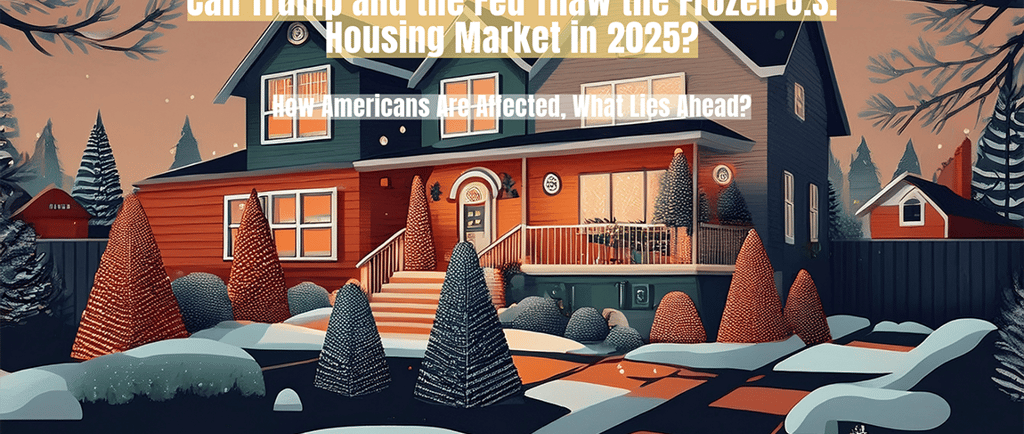Can Trump and the Fed Thaw the Frozen U.S. Housing Market in 2025?
4/22/20253 min read


Can Trump and the Fed Thaw the Frozen U.S. Housing Market in 2025?
The U.S. housing market in April 2025 is like a car stuck in mud—wheels spinning, but progress is slow. Home prices inch up at a sluggish 3%, affordability is a growing barrier, and supply shortages persist. With Donald Trump’s policies shaking things up and the Federal Reserve steering monetary policy, the market faces a complex mix of forces. Will these powers unlock the market or keep it frozen? Let’s explore the trends, policies, and their impact on American dreams of homeownership.
A Market in Slow Motion
The housing market is growing, but barely. J.P. Morgan Research forecasts a 3% rise in home prices for 2025, a sharp contrast to the frenzied growth of recent years. Median home prices, now roughly 5.2 times the median household income, are pricing out first-time buyers. Mortgage rates hover between 6.6% and 7% for a 30-year fixed loan, with projections suggesting a slight dip to 6.7% by year-end. Inventory is improving—months’ supply rose to 4.1 from 3.7 in 2024—but a historic shortage of millions of homes lingers. Experts estimate it’ll take over seven years to close the gap at current construction rates.
For Americans, this translates to tough choices. Young families are stuck renting, while homeowners with low-rate mortgages from the pandemic era hesitate to sell, locking up supply. The result? A market that’s neither booming nor busting—just stagnant.
Trump’s Policies: A Double-Edged Sword
Since taking office on January 20, 2025, Trump’s agenda—tariffs, tax cuts, deregulation, and immigration reforms—is reshaping the housing landscape:
Tariffs on Imports: Trump’s tariffs, including up to 125% on Chinese goods and 25% on Canadian and Mexican imports (partially paused), are hiking construction costs. Lumber and steel prices are spiking, slowing new home builds and pushing up home prices.
Tax Cuts and Deregulation: Extending the 2017 tax cuts and easing environmental and zoning rules aim to boost construction and household budgets. These could spur demand and supply, but benefits may take years to materialize.
Immigration Crackdowns: Stricter enforcement risks shrinking the construction workforce, where 25% are immigrants, further delaying projects and raising costs.
The Federal Reserve’s Role
The Fed’s monetary policy is a critical driver of the housing market, influencing mortgage rates and affordability:
Interest Rate Policy: After aggressive rate hikes in 2022–2023 to combat inflation, the Fed cut rates by 50 basis points in late 2024, bringing the federal funds rate to 4.25–4.5%. However, Trump’s tariff-driven inflation has stalled further cuts, with rates holding steady in early 2025. This keeps mortgage rates elevated, dampening demand. A $300,000 loan at 7% costs about $150 more per month than at 6%.
Inflation Management: The Fed is caught in a bind. Tariffs are pushing up goods prices, with inflation ticking up to 3.2% in Q1 2025. The Fed may delay rate cuts to curb inflation, prolonging high borrowing costs for homebuyers.
Market Signals: Fed Chair Jerome Powell has signaled caution, citing tariff uncertainty and robust job growth (unemployment at 3.8%). This suggests rates may stay higher for longer, frustrating buyers hoping for relief.
The interplay between Trump’s policies and the Fed is crucial. Tariffs fuel inflation, limiting the Fed’s ability to cut rates, while tax cuts could overheat demand, prompting tighter policy. This tug-of-war keeps the market in limbo.
How Americans Are Affected
The combined impact of Trump’s policies and the Fed’s stance varies by group:
First-Time Buyers: High rates and prices make homeownership a distant goal. A $400,000 home with a 7% mortgage consumes over 40% of median incomes, forcing many to rent or relocate to cheaper areas like Boise or Raleigh.
Homeowners: Those with 3% mortgages from 2020–2021 hold $305 trillion in equity but are “rate-locked,” unwilling to sell, and face today’s rates, tightening inventory.
Renters: Rents, up 4% year-over-year, are climbing faster with tariff-driven inflation, squeezing urban renters in cities like San Francisco and New York.
Regional Dynamics
Sun Belt states like Texas and Florida see stronger demand due to migration, but tariff costs slow construction. Coastal markets remain unaffordable, with sluggish sales. Smaller cities offer relative affordability but struggle with low inventory.
What Lies Ahead?
The market’s path hinges on Trump and the Fed. If deregulation boosts construction, supply could ease by late 2025, cooling prices. But persistent inflation from tariffs may force the Fed to keep rates high, worsening affordability. Buyers might find deals in less competitive markets, while sellers with equity can still profit, but for many, homeownership feels out of reach.
Thought Questions
How are Federal Reserve rate decisions impacting your local housing market?
Should buyers wait for potential rate cuts or act now despite high costs?
Can Trump’s deregulation offset the Fed’s cautious stance to unlock the housing market?
hello@boncopia.com
+13286036419
© 2025. All rights reserved.